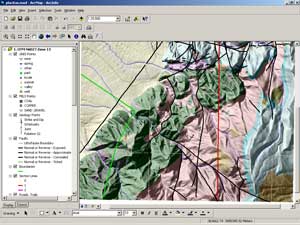Take a Virtual Geology Field Trip

| Take a Virtual Geology Field Trip |  |
|
Once the ArcGIS version of the Placitas geology model is finished, zoom into several areas and explore the Geology Poly, Faults, and Geology Points layers. Notice that joints in the old Sandia granite are aligned primarily in a northeast direction, often parallel to faulting. Schistosity and foliation in metamorphic rocks, including the oldest schists, phyllites, and amphibolites, also display a predominant northeast orientation. Dips measured in the Paleozoic sediments are predominantly to the east, northeast, and north. Notice that the dips in sedimentary units are very consistent within individual fault blocks. 
Study the relationships between drainages and faults. Observe that streams often flow along the east-west faults as they flow west away from the mountain. Fault movement often weakens the otherwise competent rock, making it easier for stream erosion to carve a channel along the softer faulted material. Find the only coal mine in the area. Look at the attribute table for the MILS points layer by right-clicking on the layer name in the Table of Contents and choosing Open Attribute Table from the context menu. The coal mine is located on alluvial material just above the Upper Cretaceous Menefee formation, an important coal producer in the area. Identify the geologic unit that hosts most of the copper occurrences. (A hint: It is located just above a major unconformity with underlying Sandia granite or older metamorphic rocks.) See if you can find the one sand and gravel occurrence. Building in Albuquerque and the Central Rio Grande Valley has created a demand for aggregate--sand, gravel, and crushed rock--used for construction. The only gravel pit in this project is located in Piedmont Deposits. Because transportation is the largest single cost incurred, most aggregate producers develop gravel pits in close proximity to growing communities. Aggregate operators now use GIS to remediate and mitigate the impact of mining and transportation operations. Mini Geology Glossary
|